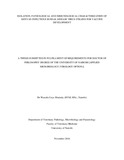| dc.description.abstract | Infectious bursal disease (IBD), a viral disease that affects young chickens, is a disease of
economic importance and a great challenge to the poultry industry world-wide. Full protection
against very virulent (vvIBDV) and variant strains may not be induced by standard vaccines. In
Kenya, IBD outbreaks are rarely reported in indigenous chickens. The objectives of this study were
to document the severity of the disease in indigenous chicken flocks compared to layers and
broilers; isolate the virus using indigenous chicken embryos; and characterize the isolated viruses
with respect to pathogenicity and immunogenicity with a view to develope a local vaccine.
A t-test and Chi square analysis were used to determine difference in mortality rates between the
flock types and any association between level of mortality rate and type of flock, respectively.
There was no statistically significant difference (P≥0.05) in mortality rates (measure of severity)
of infectious bursal disease outbreaks between broilers, layers and indigenous flock types and no
association between type of flock and level of mortality rate. Indigenous chicken embryos were
successfully used in virus isolation; 44 IBDV isolates were obtained. Four (E19, E9, E7 and E42)
out of the 44 isolates were selected for pathogenicity testing to represent those that had caused
different mortality rates in the field; low moderate and high. Each of the selected isolates was
inoculated into 36 five-week old indigenous chicks at a viral dose of 104 EID50 per chicken.
Symptomatic index score scale ranged from 0 (lack of signs) to 3 (prostration and death) and
histology score scale ranged from 0 (no damage) to 5 (loss of all glandular architecture). The data
was analyzed using analysis of variance (two-way ANOVA). Mean symptomatic index scores
were highest on days 3 and 4 post inoculations for all the isolates. Highest scores were 2.4 (isolate
E9, day 4), 2.2 (isolates E19 and E7 day 4 for both) and 1.6 (isolate E42, day3). Organ index score
did not vary between isolates (P≥0.05). Severest damage to glandular architecture was seen in | en_US |



